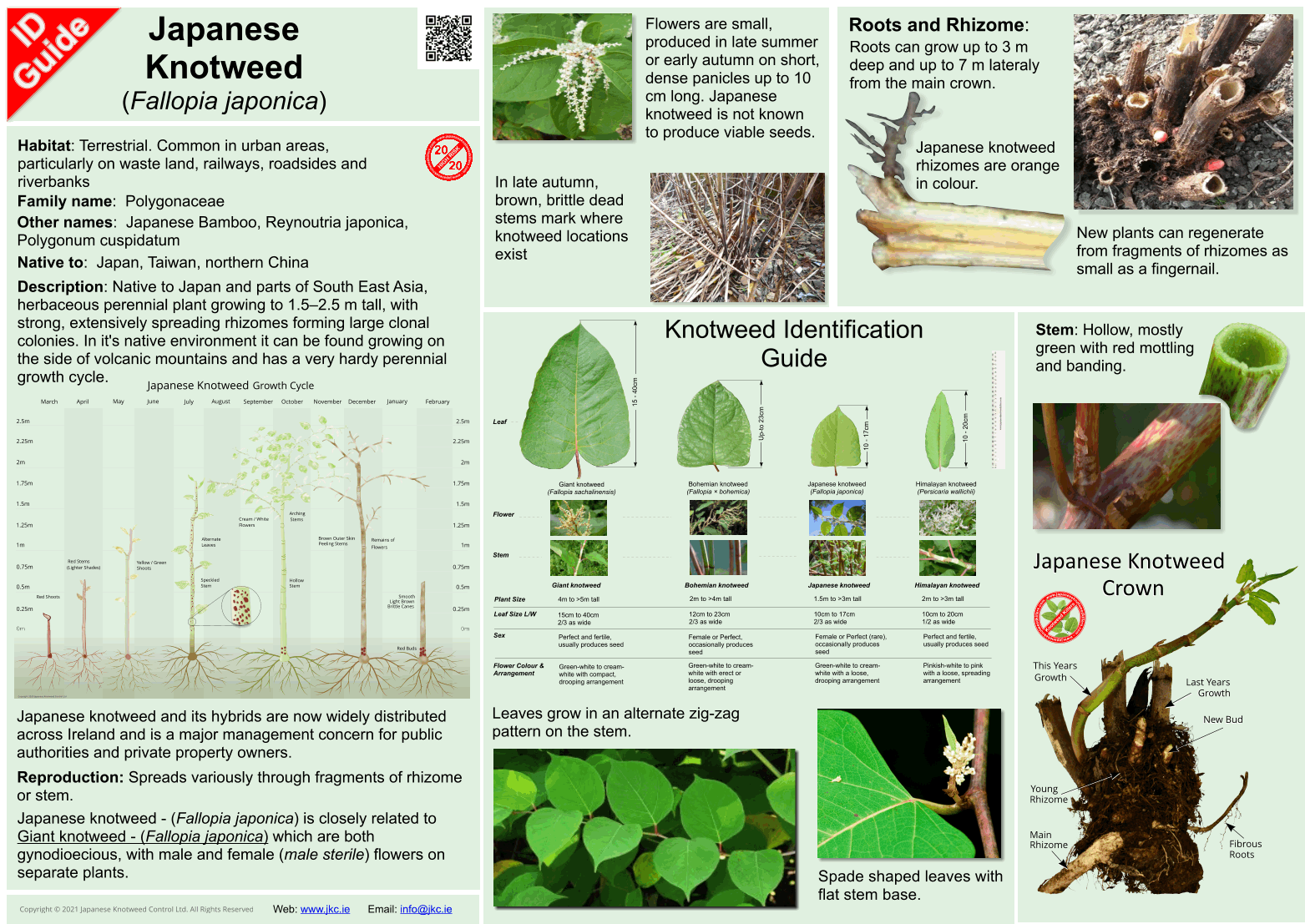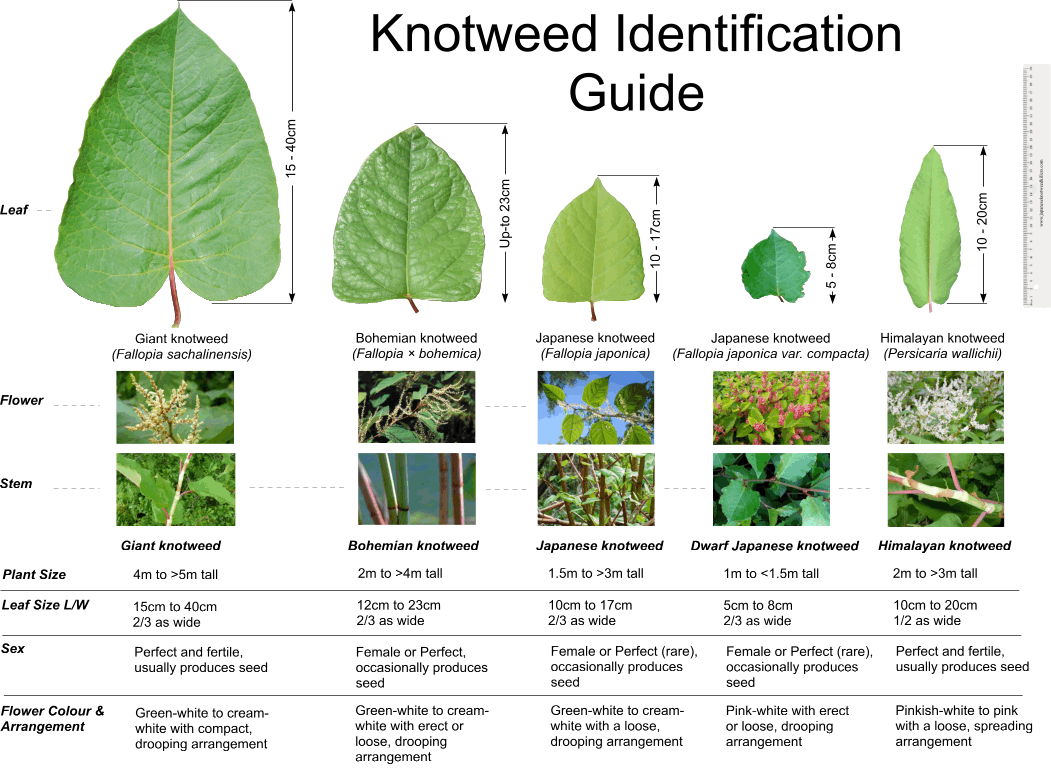

Ireland: Kerry - Dublin - Cork - Waterford - Roscommon - Galway - Belfast
UK: London - Manchester - Newcastle - Cardiff - Liverpool


Japanese knotweed
Invasive Weed Information

What Is Japanese knotweed (Fallopia japonica - Gliúneach bhiorach)?
Habitat: Terrestrial. Commonly found along river banks, roadsides, urban areas, waterways and railways. Likes disturbed ground.
Distribution In Ireland: Extensive and widespread
Status: Established
Family name: Polygonacae
Reproduction: Speeds through vegetive means. Fragments of rhizome or stem.
Native to Japan and parts of South East Asia, Japanese knotweed is used to extremely harsh conditions. In it's native enviroment it can be found growing on the side of volcanic mountains and has a very hardy perennial growth cycle. Japanese knotweed and it's hybrids are now widely distributed across Ireland causing a major management concern for public authorities and private property owners.
Japanese knotweed images

Japanese Knotweed - Fallopia japonica autumn leaf Ireland

Japanese Knotweed - Fallopia japonica Ireland - Autumn leaf

Japanese Knotweed - Fallopia japonica Ireland winter canes

Japanese Knotweed - Fallopia japonica autumn leaf Ireland
The plant has no natural predators in Ireland and thrives in wet land conditions. It can spread from root fragments left behind when ground is disturbed, which is why it can often be found along waterways and at road sides.
How to Identify Japanese Knotweed?

Japanese knotweed - Fallopia japonica ID Guide
Colour: Vibrant Green
Leaf: Bright Green, spade shape
Flower: Creamy white, delicate & small
Stem: Red/purple & green, hollow (similar to bamboo)
Root: Tough, orange/brown with white shoots


Japanese knotweed autumn leaf & stem
Why Is Japanese Knotweed A Problem?
Japanese knotweed has become a serious problem in Ireland and many other parts of
Europe due to it's aggressive spread and speed of growth causing extensive damage to building and structures.
Having Japanese knotweed can seriously effect the value of properties and prevent the approval of planning permission for site development.
Japanese knotweed Time-Lapse Video

Japanese knotweed is one of the most problematic invasive alien species in Ireland becoming a common sight on rural properties, waterways, roads and in wetland habitats.
It is classified as one of the top 100 worst invasive species worldwide due to its serious impact on biological diversity, impact on human activity and its capacity to invade new environments.
Japanese knotweed Leaf & Flower
Japanese knotweed
Fallopia japonica - Gliúneach bhiorach

Knotweed is now widely distributed across Ireland and is a major management concern for public authorities and private property owners.

New shoots breaking through tarmac
Once established Japanese knotweed can grow at a veracious rate, establishing a root system that can spread up to 7 metres from the plant surface and up to 2 metres down.
The rhizomes (nodes on the plant root) are packed with energy and can remain dormant for up to 20 years!
Japanese knotweed is relentless in growing through almost any barrier. It has no problem breaking through weak concrete, brick, paving slabs and tarmac and will push its way to the surface at an alarming rate.
The impact on properties can be devastating.


Japanese knotweed can quickly establish dense standings
Japanese knotweed Removal
If you discover Japanese knotweed on your property the first thing you will probably do is to try to find out how to get rid of it.
Having Japanese knotweed on your property is enough to strike dread into the heart of any property owner, bearing in mind all the negative media coverage that it has gained during the past few years.
Property buyers and developers have experienced difficulties securing mortgages for properties affected by Japanese knotweed and some lenders reject outright any property affected by knotweed, others take a more practical view and lend where the infestation is being treated.
Japanese knotweed thrives on disturbance and invades environments where soils are routinely disturbed and transported.
-
Do not strim, cut, flail or chip the plants as tiny fragment can regenerate new plants and make the infestation harder to control
-
Do not attempt to dig out Japanese knotweed, this can actually encourage the plant into growing faster, therefore colonising an area more aggressively
-
Do not move or dump soil which may contain plant material as this may also add to its spread
-
Do not attempt to pull the plant out of the ground, as this can expose part of the infectious crowns, stimulating growth
-
Do not use unlicensed herbicides close to any watercourses, plants or wildlife
-
Do not compost any part of the plant, due to the resilient nature of knotweed it could survive and grow on when the compost is ready for use
-
Do not dispose of Japanese knotweed in garden waste allotments as this just transports the plant to new locations
-
Do not spread any soil that has been contaminated with Japanese knotweed rhizome as new plants will sprout
-
Do not do break the law! – Remember, it is an offence if you cause the spread of Japanese Knotweed either intentionally or unintentionally